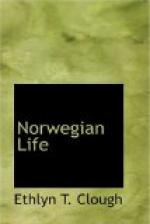Everybody who has taken the trouble to make the journey, of course, advises other people to do the same, and insists that it is worth the time, money, and fatigue it costs, on the same principle as the fox that lost his tail in a trap wanted all the other foxes to cut off their tails. There is one train each way daily, but it runs very slowly,—about fifteen or eighteen miles an hour,—and stops a long time at the stations. The cars are comfortable. The road belongs to the government, and was built in the ’90’s for the transportation of ore from the iron mines, which was previously hauled by cart in summer and reindeer sledges in winter, to the ports of Lulea and Allapen, a distance of about one hundred and forty miles.
When it is recalled that two-thirds of the inhabitants of Norway live upon the coasts and fjords, the large part which water traffic plays in the economy of the country will be easily understood. The coast being well protected by a chain of islands, the skjaergaard, both travel and commerce are carried on by means of small open boats. The fjord rowboats, as a rule, are light and pointed, with upright and high prow, and they carry a square sail. They are light to row, and they go capitally before the wind. There is an extensive government posting system on the coasts, fjords, and inland lakes, similar to that along the public highways already described. The tariff from fast stations for a four-oared boat and sail with two rowers is about twelve cents a mile; eighteen cents for three rowers and a six-oared boat, and twenty-four cents a mile for a boat with eight oars and four rowers. The tariff is decided by the size of the boat and not by the number of passengers. The rowers are not infrequently girls and women.
The large fjords and lakes have ample steamboat facilities, the coast service between Bergen and Trondhjem being especially good. The navigable channels of the fjords represent a coast line of twelve thousand miles, and they are so entirely separated from the sea by islands and reefs and obstructed at their entrances by old moraines, that the fresh water from the melting snows and rivers lies four or five feet deep on the surface. Small steamers ply on all the larger fjords on which the rates are moderate and the accommodations fair. On most of these boats a passenger pays full fare for himself and half fare for the other members of his family, including his wife. Persons who want to see the fjords of Norway thoroughly should take the regular mail steamers, which call at all small ports and take a month instead of a week for the voyage. The boats are small, but clean and comfortable, and only occasionally have bad weather—very seldom in summer. They wind in and out of the narrow passages, and because of their size can navigate where the larger tourist steamers are not able to go, and therefore the passengers on the latter miss some of the finest scenery.
Voyages to the North Cape by the tourist steamers are limited to a few weeks during the midsummer, when the sun is supposed to be visible at midnight in the arctic regions, but steamers run regularly all the year way around the Cape to Archangel, Vadsoe, and Horningsvaag, the arctic ports of Russia. The fjords never freeze, so that navigation is always open, and there is more or less travel in midwinter between the civilized portions of the arctic regions.




